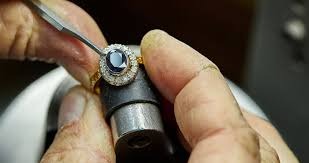Few things spark panic faster than a missing diamond. And with repair work bringing in about 15% of a typical jewelry store’s revenue and roughly 60% of its foot traffic, losing even one stone can deliver a costly blow. One slip and a quarter-carat gem vanishes between floorboards, turning a simple resize into a nightmare. Fortunately, most losses are avoidable. Pair smart bench habits with a Jewelry store pos system that tracks every job in real time, and you create a clear chain of custody from drop-off to pick-up for everyone on the team. Here are five ways that will help you keep every stone safe, protect profit, and send customers home smiling every time.
- Secure the Setting Before Work Begins
Start every ring repair with a close look at the setting. Under a 10× loupe, inspect each prong for flat tips, cracks, or gaps. Give every prong a light nudge with a probe; if it flexes, re-tip or tighten before you bring heat or vibration near the stone. Loose claws can spring open during polishing, ultrasonic cleaning, or even light sawing, sending a gem skittering across the bench. Note any weak spots on the job ticket so the client knows why extra work was needed. A five-minute check prevents a costly replacement stone and spares you the frantic search under workroom lights. You should treat this step as non-negotiable. Make sure that no torch, file, or hammer touches the ring until the stone sits firm and secure in its seat.
- Use Dedicated Gemstone Trays
Shared bench cups invite mix-ups. Give every loose gem its own felt-lined tray instead. Choose bright colors so staff can spot the right tray at a glance. The moment you remove a stone, place it in the tray, write the job number on a small tag, and slide a clear acrylic lid over the top. Add a quick description with a fine marker. If you work on multiple rings for one client, stack trays in a small rack but keep labels facing forward. The soft lining stops chips, the lid blocks rolling, and the tag ties the gem to the ring without guesswork. At the end of each shift, check the rack against the day’s tickets. This habit will save you from losing a gemstone ever again.
- Bag and Tag Loose Stones Immediately
Even a labeled tray isn’t enough when a gem leaves your bench for casting, rhodium, or outside appraisal. Slip each stone into a tiny zip-top bag the moment it’s removed. Drop in a printed barcode or QR label that lists carat weight, cut, and customer ticket number, then seal the bag and place it in a lockable drawer. Scan the code into your Jewelry store pos system so anyone can see the details quickly. Snap a quick photo of the bag next to the ring mount and attach it to the digital ticket for proof. This two-minute routine creates an audit trail that follows every gem, slashes hand-off confusion, and keeps irreplaceable stones from wandering off during multi-step repairs.
- Keep a Stone Catch Mat Under the Bench
Gravity is a thief. One bounce and a gemstone can vanish into cracks you didn’t know existed. Line the floor beneath each bench with a fine-mesh stone catch mat or magnet-backed fabric. The mesh slows a falling gem, while the soft backing cushions it to prevent chips. Choose a mat wide enough to cover the area where you file and polish. Sweep the mat at day’s end with a hand vacuum and empty the canister over a white tray. You will be shocked at the tiny treasures it collects. Note any recovered stones on their tickets and place them back into labeled bags before leaving. This mat will protect thousands in inventory and save technicians from crawling on hands and knees every time a prong slips.
- Document Every Step with Photos
A picture locks down details no log line can match. Before any work begins, take a clear macro shot of the ring from all sides. Take another photo after you remove the gem, showing the empty seat and the tagged bag beside it. Capture mid-process images when prongs are half-retipped or the shank is spread, then a final glamour shot once polishing is finished. Store each image on the job ticket so every team member and the customer can review the timeline. Photos prove the stone you returned is the stone you received, and they settle disputes in seconds.
Keep Every Stone Safe
And there you have it – five easy habits that keep every gem safe from bench to pickup. Tighten prongs before work, place stones in color-coded trays, bag and tag each gem, spread a catch mat under the bench, and snap photos at every stage. You should also log each step in your Jewelry store pos system, so that anyone on the team can trace a diamond’s exact spot in seconds. Clear records calm customers, prevent costly mix-ups, and send every repaired ring home sparkling with stone, setting, and trust all secure.

